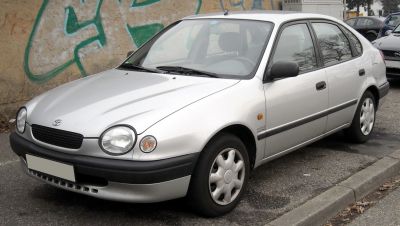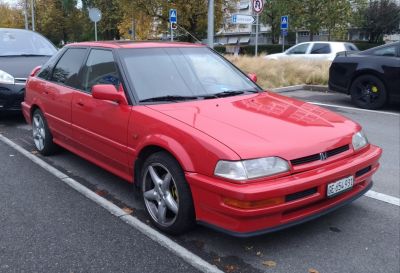 1980 Citroen GSA Dimensions, Size & Specs
1980 Citroen GSA Dimensions, Size & SpecsMeasurements of the 1980 Citroen GSA, engineered for optimal performance and comfort
| Dimensions | |
|---|---|
| Length: | 4181 mm164.6 in13.7 ft |
| Width: | 1626 mm64.0 in5.3 ft |
| Height: | 1349 mm53.1 in4.4 ft |
| Ground Clearance: | 154 mm6.1 in0.5 ft |
| Trunk Capacity: | 435 liter15.4 cu ft |
| Trunk Capacity (Max): | 1400 liter49.4 cu ft |
| Weight Specifications | |
| Curb Weight: | 920 kg2028 lbs |
| Maximal permitted Weight: | 1365 kg3009 lbs |
| Tire Specifications | |
| Rims Size: | 15-inch rims:
|
The Citroen GS GSA, produced between 1979 and 1986, represents a practical and compact hatchback choice from the early 1980s. Launched as an evolution of the original GS, the GSA featured subtle design updates while maintaining its signature aerodynamic shape. Measuring 4181 mm (164.6 inches) in length, 1626 mm (64 inches) in width, and 1349 mm (53.1 inches) in height, this vehicle fits comfortably within the compact car segment. Weighing in at a curb weight of 920 kg (2028 lbs) and a maximum weight of 1365 kg (3009 lbs), the GS GSA offers an agile driving experience without compromising on stability and comfort.
The hatchback’s practical design is emphasized by its impressive luggage capacity: 435 liters (15.3 cubic feet) with all seats upright and expanding to a generous 1400 liters (49.4 cubic feet) when the rear seats are folded flat, making it an excellent choice for drivers seeking versatility. The ride height or ground clearance is set at 154 mm (6.06 inches), ensuring adequate clearance over typical road obstacles while contributing to the car’s smooth ride characteristics.
Equipped with 15-inch rims measuring 4.5J x 15, the car balances ride comfort and handling, consistent with Citroen’s focus on advanced engineering for its time. The GS GSA's size and weight were well-suited to urban environments and longer journeys alike, providing a spacious interior for passengers and cargo in a compact footprint. Overall, the Citroen GS GSA of 1980 remains a noteworthy model for enthusiasts and those interested in classic European hatchbacks, blending efficient use of space with classic styling and Citroen’s hallmark innovative approach.
Discover the standout features that make the 1980 Citroen GSA a leader in its class
Have a question? Please check our knowledgebase first.
The Citroen GS/GSA hatchback produced between 1979 and 1986 has a length of 4181 mm (164.6 inches), a width of 1626 mm (64.0 inches), and a height of 1349 mm (53.1 inches). These dimensions made it a compact and aerodynamically styled car for its era, suitable for city driving while providing a relatively spacious interior for its class.
The Citroen GS/GSA has a curb weight of 920 kg (2028 pounds) and a maximum weight of 1365 kg (3009 pounds). This relatively light weight contributes to its agile handling and fuel efficiency. The light construction, combined with Citroen's innovative hydropneumatic suspension system, provided a smooth ride and good road handling, especially notable for a hatchback of the early 1980s.
The luggage capacity of the Citroen GS/GSA with the rear seats in place is 435 liters (about 15.3 cubic feet), which is ample for everyday use and small family trips. When the rear seats are folded down, the space expands significantly to 1400 liters (approximately 49.4 cubic feet). This versatility made the GSA practical for carrying larger loads or luggage, enhancing its appeal as a hatchback.
Yes, the Citroen GS/GSA fits comfortably into a standard garage. With a length of 4181 mm (164.6 inches), width of 1626 mm (64.0 inches), and height of 1349 mm (53.1 inches), it is more compact compared to many modern cars. This ensures that parking in typical residential garages, which generally accommodate vehicles up to around 6 meters (about 236 inches) in length and 2.5 meters (98 inches) in width, is hassle-free.
The Citroen GSA was an evolution of the original GS rather than a radical redesign. Dimensionally, the GSA retained much of the GS’s size, but featured slight changes to increase interior comfort and improve aerodynamics, such as a more angular body style. Both shared a similar length around 4181 mm, but the GSA generally optimized interior volume, improved luggage capacity, and offered more modern features while keeping a compact footprint akin to the GS.
Compared to contemporaries like the Volkswagen Golf Mk1 or Ford Escort Mk3, the Citroen GS/GSA was similar in length but slightly narrower and lower in height. The Golf Mk1, for example, measured about 3,930 mm long (154.7 inches), making the GS/GSA longer by about 250 mm. Although somewhat larger, the GS/GSA's distinctive hydropneumatic suspension and hatchback design emphasized a smooth ride and practical interior space. Its luggage capacity also tended to be more generous than many competitors of the era.
The GS/GSA has a ride height or ground clearance of 154 mm (6.1 inches). This moderate clearance combined with Citroen's renowned hydropneumatic suspension system allowed the car to maintain excellent ride comfort and good road handling, even on rough or uneven surfaces. This setup helped absorb shocks and kept the cabin stable, making it more comfortable than many rivals in its class when driving on challenging road conditions.
The Citroen GS/GSA came equipped with 15-inch rims, specifically sized 4.5J x 15. These relatively large wheel sizes for a small hatchback allowed for better grip and stability on the road, complementing the hydropneumatic suspension’s effectiveness in smoothing out bumps. The combination balanced dynamic driving characteristics with comfort, contributing to the car's acclaim for a ride quality that was superior to many competitors of its time.
The Citroen GS/GSA stood out in the early 1980s for its hydropneumatic self-leveling suspension system, which provided a remarkably smooth ride and good road handling unmatched by many competitors. Its aerodynamic shape, advanced for the era, helped improve fuel efficiency. The hatchback design featured a versatile and spacious cargo area, with rear seats folding flat to expand luggage space significantly — a practical feature highly appreciated by drivers. Additionally, the GSA introduced some modern styling and equipment updates compared to the GS, continuing Citroen's reputation for innovative engineering.
Given its compact dimensions, moderate powertrain, and excellent ride comfort due to the hydropneumatic suspension, the Citroen GS/GSA remains very practical for urban and suburban driving. Its size allows easy maneuvering and parking in tight spaces, while the hatchback design offers good cargo flexibility. However, due to its age, modern drivability may be affected by older technology and emissions standards. Overall, it’s a charming classic that suits city environments well but may require careful maintenance and consideration in contemporary traffic conditions.
Discover similar sized cars.

| Production: | 1997-2001 |
|---|---|
| Model Year: | 1998 |
| Length: | 4270 mm168.1 in |
| Width: | 1690 mm66.5 in |
| Height: | 1385 mm54.5 in |

| Production: | 2001-2003 |
|---|---|
| Model Year: | 2001 |
| Length: | 4110-4280 mm161.8-168.5 in |
| Width: | 1655 mm65.2 in |
| Height: | 1360 mm53.5 in |

| Production: | 1993-2007 |
|---|---|
| Model Year: | 1993 |
| Length: | 4270 mm168.1 in |
| Width: | 1680-1690 mm66.1-66.5 in |
| Height: | 1385 mm54.5 in |

| Production: | 1989-1995 |
|---|---|
| Model Year: | 1989 |
| Length: | 4265 mm167.9 in |
| Width: | 1690 mm66.5 in |
| Height: | 1395 mm54.9 in |
